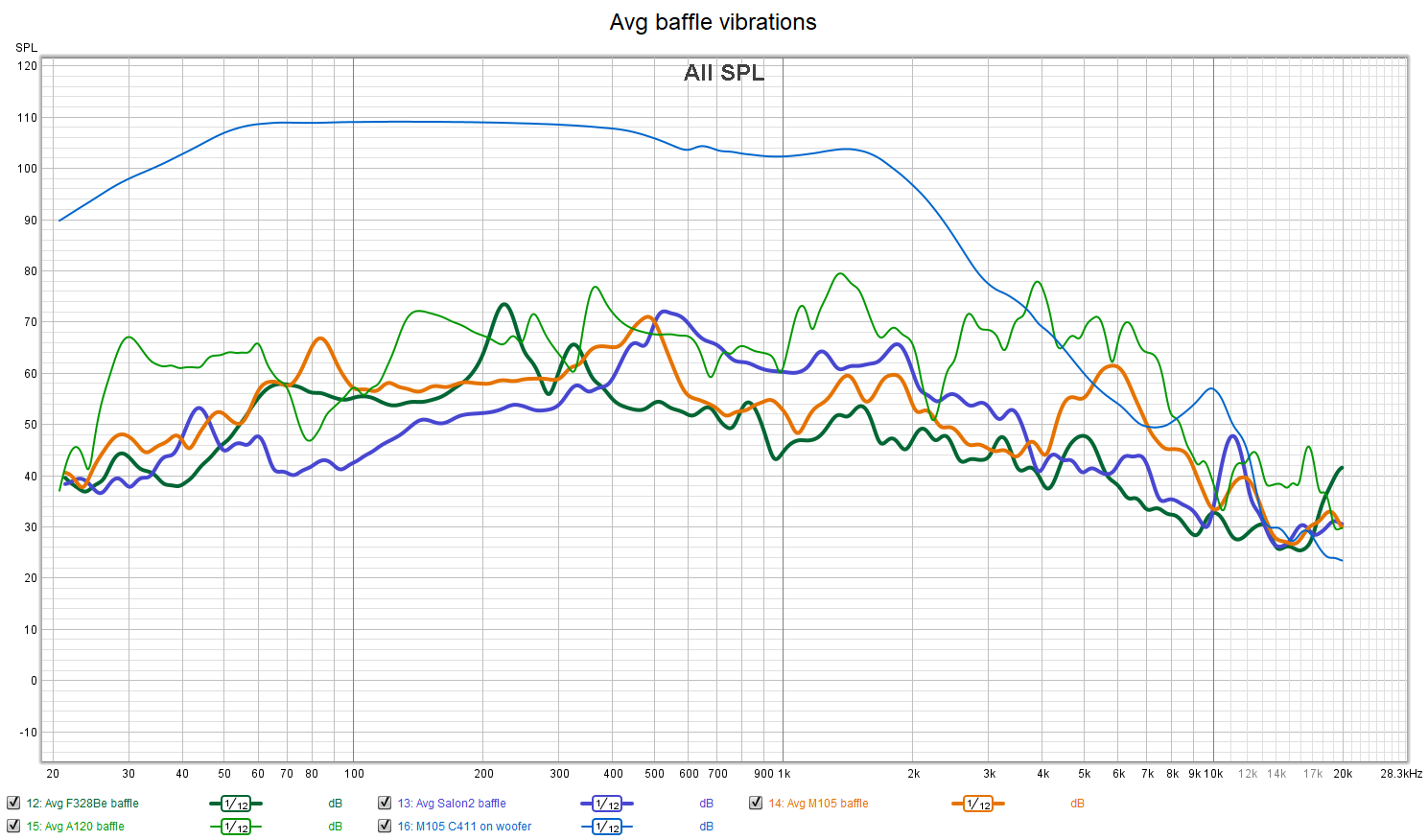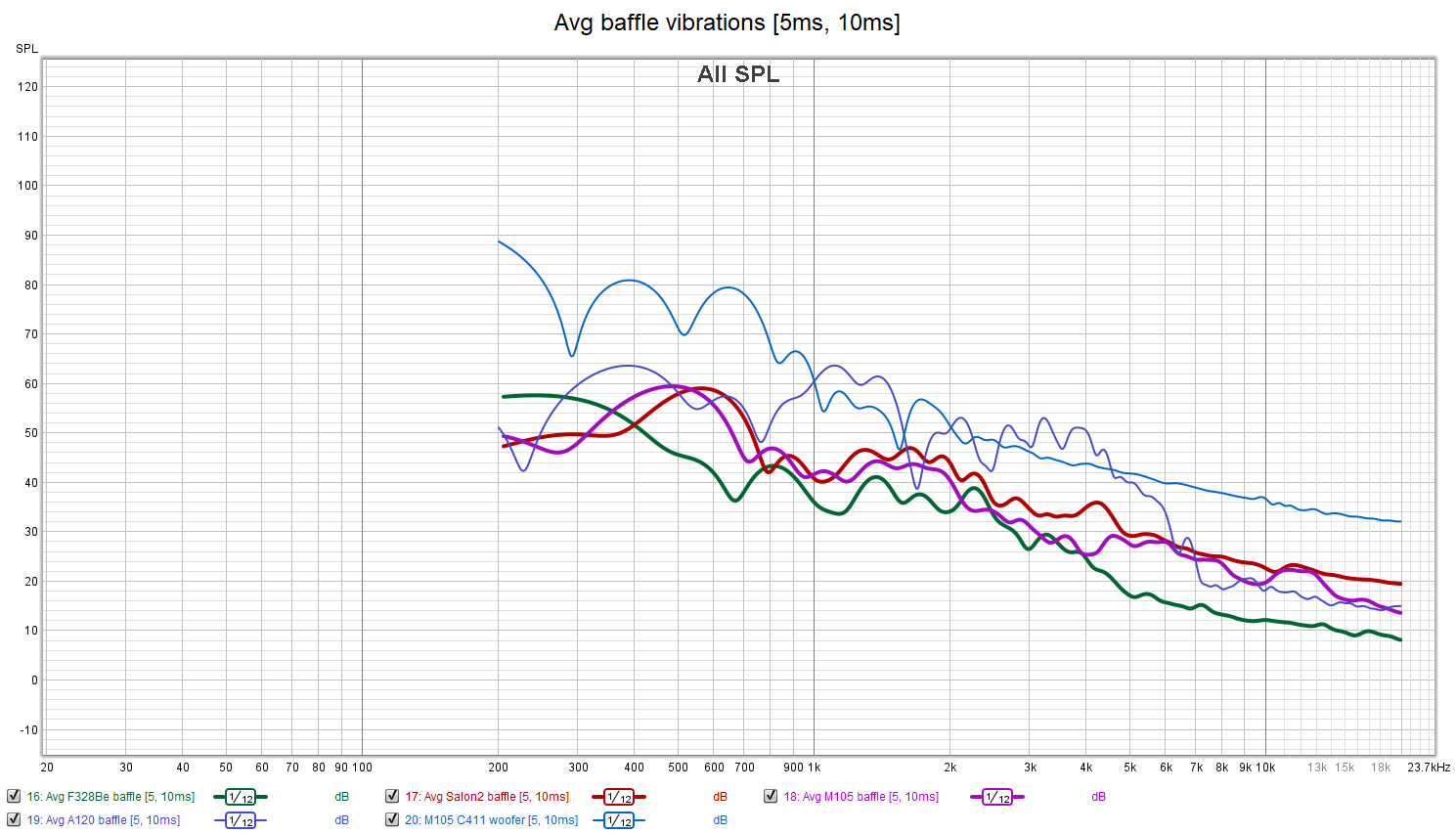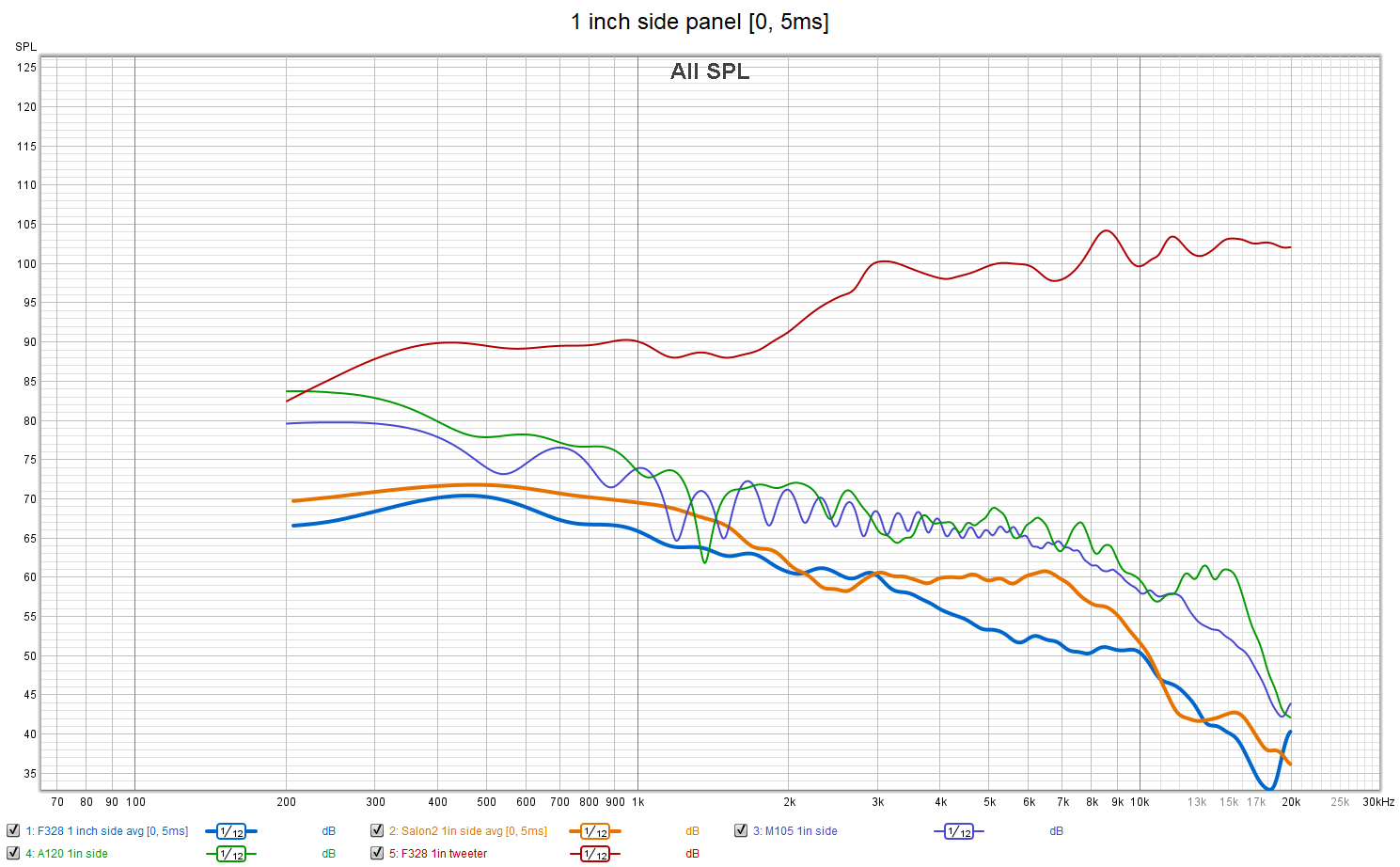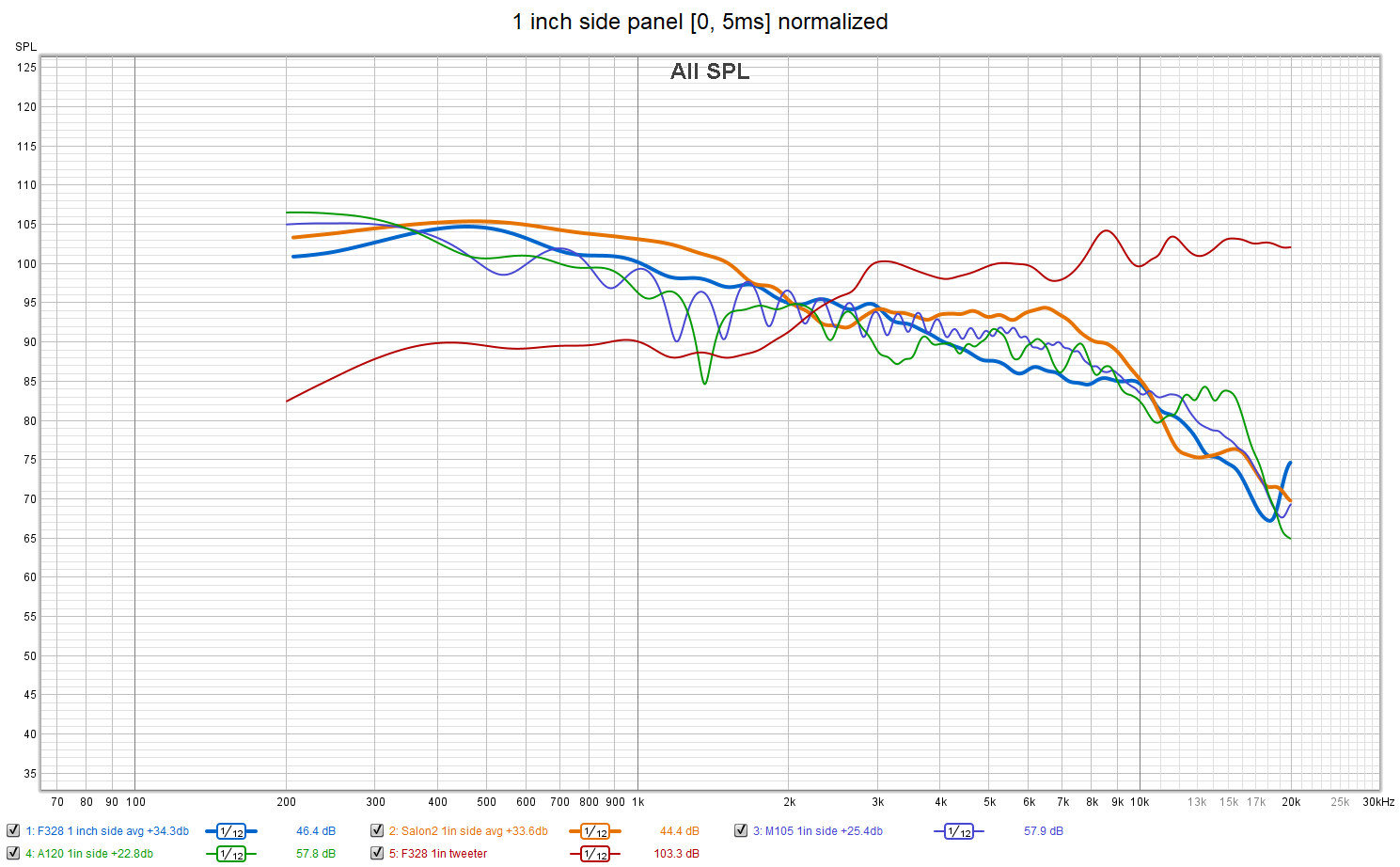neutralguy
Member
- Joined
- Apr 16, 2019
- Messages
- 68
- Likes
- 157
I had posted previously about a tweak to speaker feet that reduced cabinet vibrations and made an audible difference even with frequency response hardly affected. Extending that work, the motivation here was to compare cabinet vibrations among speakers to see if we can learn more about how they affect the sound. The speakers tested were Revel F328Be, Revel Salon2, and Revel M105. I also threw in the much cheaper bookshelf JBL A120 as a sort of anchor.
Vibration Measurements
First let's look at baffle vibrations. I measured cabinet vibrations as before by attaching an AKG C411 vibration microphone using blutack. To get a comparison for the sound levels caused by vibrations, I also measured M105 5" woofer's "vibrations" the same way, sticking the C411 onto the woofer cone. (In a separate measurement not shown, I found that the lightweight C411 mounted on the woofer did not significantly affect its frequency response or distortion, except to lower it by a flat 1db across its range.) The M105's crossover has the woofer working up to about 2.3khz. All speakers were playing at a level of 85db @ 1 foot, corresponding to a good volume at the listening position. Each baffle was measured at 3 locations at varying heights, except for the A120.

Absolute levels here are vibrations and not spl, but note that the woofer's vibrations are responsible for the 85db sound output. We can see from this graph that up to the driver's range of 2.3khz, all surfaces vibrated significantly less than that of the driver, generally by 30-40db. Although each baffle has larger surface area than a 5" driver, the baffle may not be moving as pistonicly as a driver does and transfer sound to air as efficiently. These should only be rough estimates of output spl, but a -30-40db range would be consistent with estimates based on simulations in the literature (Grande 2008). These numbers don't jump out at me as definitely audible or inaudible. One exception would be the A120's bump at 1-2khz, which at -25db spanning a sensitive octave might be audible. There's literature (Toole 1988) that shows certain -30db resonances to be audible. Note that I've shown vibration averaged over several locations, so parts of the baffle vibrate at higher levels at some frequencies, especially for the floorstanders.
What about in the time domain? In the following graph, I restricted to a 5 millisecond window [5ms, 10ms] after the initial rise to show relative differences in decay. The woofer decays more quickly than the baffle surfaces:

The A120 is also the worst performer in this time window, with levels in the 1-2khz range exceeding M105's woofer. They're both down about -40db, however, which for the woofer would mean 45db spl. This does not look likely to be a problem, especially for the Revel speakers.
I do not have vibration measurements of a C411 attached to a tweeter for comparison of frequencies above 2khz. Sound transfers to air better at higher frequencies for the same surface displacement, so we might expect higher sound output from cabinet vibrations there. To get a better sense of what's happening at high frequency, I needed a better way to isolate contributions from cabinet versus drivers.
Closeup Measurements, Diffraction
To isolate cabinet sound contributions from driver contributions, my approach was to use a normal sound microphone (Shure SM81 with levels calibrated using UMIK1) to make measurements at 1 inch and time window to the first milliseconds. Close micing allows sound from the nearby cabinet surface to dominate over sound from drivers, and time windowing prevents any reflections from entering the picture. Also, the measurements were taken from the cabinets' side to get farther away from the drivers. For say the F328Be, the path distance from the tweeter to the middle of the side panel at tweeter height is about 12 inches. If we use the free space dropoff of 6db per doubling of distance, tweeter output is diminished by 22db at that location compared to 1 inch in front of tweeter, with more attentuation due to having to diffract around the baffle.
The following are measurements at 1 inch from each speaker's side panel, taken in the middle for the bookshelfs and averaged over 3 height locations for the two floorstanders, and time windowed to the first 5 milliseconds. All speakers were set to output 86db at 1 foot. Also included is a measurement 1 inch in front of F328's tweeter for comparison.

It's clear that the two bookshelfs have higher sound emissions than the two floorstanders in this measurement, by about 10db give or take. However, these curves do not have the peaks and valleys of side panel vibration curves (not shown), which would be strange if vibrations were the source. If the sound measured here is not coming from the cabinet, the only other possibility is that it indeed came from the drivers making the 90 degree turn around the baffle edge to the side of the cabinet.
To further subdue sound from the drivers, I placed a plastic tweeter cover over the tweeter and waveguide. This should not significantly affect cabinet vibrations, but does significantly diminish sound output by the tweeter. Then I made measurements with and without the cover to compare.

Traces 1 and 2 were taken from 1 inch in front of the tweeter, covered vs uncovered. This shows that covering the tweeter indeed reduced the tweeter's output to the front. Traces 3 and 4 were taken from middle of the side panel at tweeter height. This shows that side panel closeup sound was likewise reduced, by an even greater amount at most frequencies, perhaps due to the cover being more effective at blocking side emission. (The bump at 9khz could be due to the tweeter cover creating a resonance of some kind.) Since covering the tweeter only blocks sound output and not cabinet vibrations, this means the closeup measurements were primarily measuring diffracted sound. At least for the side panels, whatever panel vibration induced sound exists is outweighed by sound diffracted from the front to the same location.
I did not have an effective cover for the lower frequency drivers, but since panel vibrations are at comparable levels for the lower frequencies, it seems likely that the same is true at lower frequencies as well.
Total Radiated Sound Power
We just compared average sound power at individual locations near the side panels, but the panel is not a point source of sound at these shorter wavelengths. Farther away from the panel the wavelets would interfere and cancel, resulting in the far field 90+ degree frequency response we see in polar graphs.
However, as these are high frequencies, I believe interference and phase patterns can be audible. It is, after all, why we have stereo, and why reflections are audible. To get a sense of the level of such patterns, I wanted to get an estimate of how much total sound power is being diffracted to and reemitted from the side panels.
To estimate total radiated sound power, I tried to account for the respective radiating surface areas of each speaker's side panel. All these speakers have a 1" tweeter so I'll use its 0.785 sq inch surface area as reference 0db, and normalize using back of the envelope calculations for side panel surface area (both sides):

We see that the total output power are not so different between the floorstanders and bookshelfs. This is intuitive given that the source of side panel sound emanations are from diffraction of the tweeter's output. If we apply Gauss's law to sound, a surface integral of sound power of any volume enclosing a given sound source should be equal. That's roughly what we have computed, with side panels being a very rough approximation of the surface of a volume enclosing the drivers. We do see that Salon2 is comparatively elevated 4-10khz. I believe this is due to Salon2's contoured baffle. F328Be is lower in the same region, possibly due to its wider baffle. I have more experiments in this area that are too lengthy for this post.
While these floorstanders and bookshelfs output comparable sound power to the sides, the paths the sound waves travel will vary.
Audible Effect?
Prior to these measurements, I thought that 90+ degree off axis sound were due either to cabinet vibrations, or diffraction direct from the baffle edge via the green+red path in this diagram:

After these measurements, I don't think vibration is a big factor. As for diffraction, I had not previously considered the green+blue path, thinking it's diminished as a longer path that takes a sharper turn around the baffle corner. (A more accurate diagram would have to include non-planar paths with elevation changes.) Reviewing the literature, if the example in Figure 2 of (Wei 2016) is any indication, sharper angles may only reduce diffraction by several db. The longer path may be lower in level but that doesn't mean it's irrelevant if it's delayed and causing interference, much like what a reflection does to sound. The implication is that side dispersion pattern, especially phase relationships, will be significantly affected by cabinet size and shape. This is in addition to the known issue of baffle diffraction affecting frontal sound output, targeted by mechanisms such as baffle step compensation and rounded baffle edges.
My hypothesis is that differences in diffraction to the sides are also significant due to phase and interference effects. I believe these differences account for at least some spatial quality difference between big and small speakers, causing big speakers to sound bigger. Perhaps our ears are tuned to recognize such patterns, or large cabinet panels diffuse the sound more near the source.
Summary
My takeaways based on these Revel speakers:
Vibration Measurements
First let's look at baffle vibrations. I measured cabinet vibrations as before by attaching an AKG C411 vibration microphone using blutack. To get a comparison for the sound levels caused by vibrations, I also measured M105 5" woofer's "vibrations" the same way, sticking the C411 onto the woofer cone. (In a separate measurement not shown, I found that the lightweight C411 mounted on the woofer did not significantly affect its frequency response or distortion, except to lower it by a flat 1db across its range.) The M105's crossover has the woofer working up to about 2.3khz. All speakers were playing at a level of 85db @ 1 foot, corresponding to a good volume at the listening position. Each baffle was measured at 3 locations at varying heights, except for the A120.
Absolute levels here are vibrations and not spl, but note that the woofer's vibrations are responsible for the 85db sound output. We can see from this graph that up to the driver's range of 2.3khz, all surfaces vibrated significantly less than that of the driver, generally by 30-40db. Although each baffle has larger surface area than a 5" driver, the baffle may not be moving as pistonicly as a driver does and transfer sound to air as efficiently. These should only be rough estimates of output spl, but a -30-40db range would be consistent with estimates based on simulations in the literature (Grande 2008). These numbers don't jump out at me as definitely audible or inaudible. One exception would be the A120's bump at 1-2khz, which at -25db spanning a sensitive octave might be audible. There's literature (Toole 1988) that shows certain -30db resonances to be audible. Note that I've shown vibration averaged over several locations, so parts of the baffle vibrate at higher levels at some frequencies, especially for the floorstanders.
What about in the time domain? In the following graph, I restricted to a 5 millisecond window [5ms, 10ms] after the initial rise to show relative differences in decay. The woofer decays more quickly than the baffle surfaces:
The A120 is also the worst performer in this time window, with levels in the 1-2khz range exceeding M105's woofer. They're both down about -40db, however, which for the woofer would mean 45db spl. This does not look likely to be a problem, especially for the Revel speakers.
I do not have vibration measurements of a C411 attached to a tweeter for comparison of frequencies above 2khz. Sound transfers to air better at higher frequencies for the same surface displacement, so we might expect higher sound output from cabinet vibrations there. To get a better sense of what's happening at high frequency, I needed a better way to isolate contributions from cabinet versus drivers.
Closeup Measurements, Diffraction
To isolate cabinet sound contributions from driver contributions, my approach was to use a normal sound microphone (Shure SM81 with levels calibrated using UMIK1) to make measurements at 1 inch and time window to the first milliseconds. Close micing allows sound from the nearby cabinet surface to dominate over sound from drivers, and time windowing prevents any reflections from entering the picture. Also, the measurements were taken from the cabinets' side to get farther away from the drivers. For say the F328Be, the path distance from the tweeter to the middle of the side panel at tweeter height is about 12 inches. If we use the free space dropoff of 6db per doubling of distance, tweeter output is diminished by 22db at that location compared to 1 inch in front of tweeter, with more attentuation due to having to diffract around the baffle.
The following are measurements at 1 inch from each speaker's side panel, taken in the middle for the bookshelfs and averaged over 3 height locations for the two floorstanders, and time windowed to the first 5 milliseconds. All speakers were set to output 86db at 1 foot. Also included is a measurement 1 inch in front of F328's tweeter for comparison.
It's clear that the two bookshelfs have higher sound emissions than the two floorstanders in this measurement, by about 10db give or take. However, these curves do not have the peaks and valleys of side panel vibration curves (not shown), which would be strange if vibrations were the source. If the sound measured here is not coming from the cabinet, the only other possibility is that it indeed came from the drivers making the 90 degree turn around the baffle edge to the side of the cabinet.
To further subdue sound from the drivers, I placed a plastic tweeter cover over the tweeter and waveguide. This should not significantly affect cabinet vibrations, but does significantly diminish sound output by the tweeter. Then I made measurements with and without the cover to compare.
Traces 1 and 2 were taken from 1 inch in front of the tweeter, covered vs uncovered. This shows that covering the tweeter indeed reduced the tweeter's output to the front. Traces 3 and 4 were taken from middle of the side panel at tweeter height. This shows that side panel closeup sound was likewise reduced, by an even greater amount at most frequencies, perhaps due to the cover being more effective at blocking side emission. (The bump at 9khz could be due to the tweeter cover creating a resonance of some kind.) Since covering the tweeter only blocks sound output and not cabinet vibrations, this means the closeup measurements were primarily measuring diffracted sound. At least for the side panels, whatever panel vibration induced sound exists is outweighed by sound diffracted from the front to the same location.
I did not have an effective cover for the lower frequency drivers, but since panel vibrations are at comparable levels for the lower frequencies, it seems likely that the same is true at lower frequencies as well.
Total Radiated Sound Power
We just compared average sound power at individual locations near the side panels, but the panel is not a point source of sound at these shorter wavelengths. Farther away from the panel the wavelets would interfere and cancel, resulting in the far field 90+ degree frequency response we see in polar graphs.
However, as these are high frequencies, I believe interference and phase patterns can be audible. It is, after all, why we have stereo, and why reflections are audible. To get a sense of the level of such patterns, I wanted to get an estimate of how much total sound power is being diffracted to and reemitted from the side panels.
To estimate total radiated sound power, I tried to account for the respective radiating surface areas of each speaker's side panel. All these speakers have a 1" tweeter so I'll use its 0.785 sq inch surface area as reference 0db, and normalize using back of the envelope calculations for side panel surface area (both sides):
- 1" tweeter: 0.785 sq inch (0db)
- F328Be: 1800 sq inch (33.6db)
- Salon2: 2100 sq inch (34.3db)
- M105: 275 sq inch (25.4db)
- A120: 150 sq inch (22.8db)
We see that the total output power are not so different between the floorstanders and bookshelfs. This is intuitive given that the source of side panel sound emanations are from diffraction of the tweeter's output. If we apply Gauss's law to sound, a surface integral of sound power of any volume enclosing a given sound source should be equal. That's roughly what we have computed, with side panels being a very rough approximation of the surface of a volume enclosing the drivers. We do see that Salon2 is comparatively elevated 4-10khz. I believe this is due to Salon2's contoured baffle. F328Be is lower in the same region, possibly due to its wider baffle. I have more experiments in this area that are too lengthy for this post.
While these floorstanders and bookshelfs output comparable sound power to the sides, the paths the sound waves travel will vary.
Audible Effect?
Prior to these measurements, I thought that 90+ degree off axis sound were due either to cabinet vibrations, or diffraction direct from the baffle edge via the green+red path in this diagram:
After these measurements, I don't think vibration is a big factor. As for diffraction, I had not previously considered the green+blue path, thinking it's diminished as a longer path that takes a sharper turn around the baffle corner. (A more accurate diagram would have to include non-planar paths with elevation changes.) Reviewing the literature, if the example in Figure 2 of (Wei 2016) is any indication, sharper angles may only reduce diffraction by several db. The longer path may be lower in level but that doesn't mean it's irrelevant if it's delayed and causing interference, much like what a reflection does to sound. The implication is that side dispersion pattern, especially phase relationships, will be significantly affected by cabinet size and shape. This is in addition to the known issue of baffle diffraction affecting frontal sound output, targeted by mechanisms such as baffle step compensation and rounded baffle edges.
My hypothesis is that differences in diffraction to the sides are also significant due to phase and interference effects. I believe these differences account for at least some spatial quality difference between big and small speakers, causing big speakers to sound bigger. Perhaps our ears are tuned to recognize such patterns, or large cabinet panels diffuse the sound more near the source.
Summary
My takeaways based on these Revel speakers:
- Vibration measurements showed significant differences among speakers, but did not show strong evidence regarding audibility, at least for the Revel speakers. I should clarify that this is only a statement about the limitations of drawing conclusions from these measurements, not that vibrations are always inaudible, since I had already found previously that differences in vibration in the bass can be audible even with miniscule changes to frequency response.
- Diffracted sound from drivers is a greater source of sound emanation at loudspeaker side than cabinet vibration at the same location.
- Cabinet size and shape may play a significant role in shaping 90+ degree off axis dispersion and phase.
- My hypothesis is that cabinet induced diffraction to the sides accounts for at least some general difference between large and small speakers in terms of spatial qualities.
